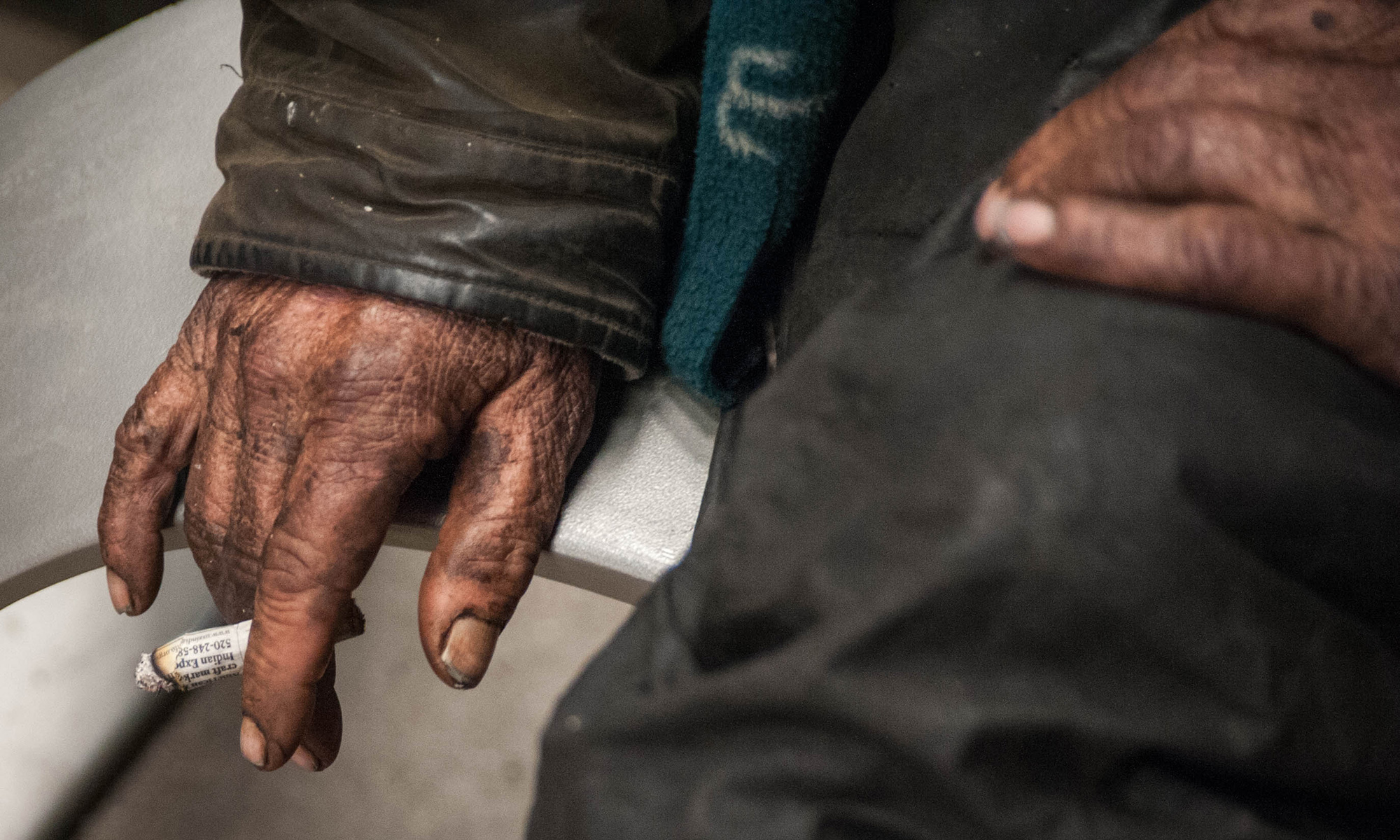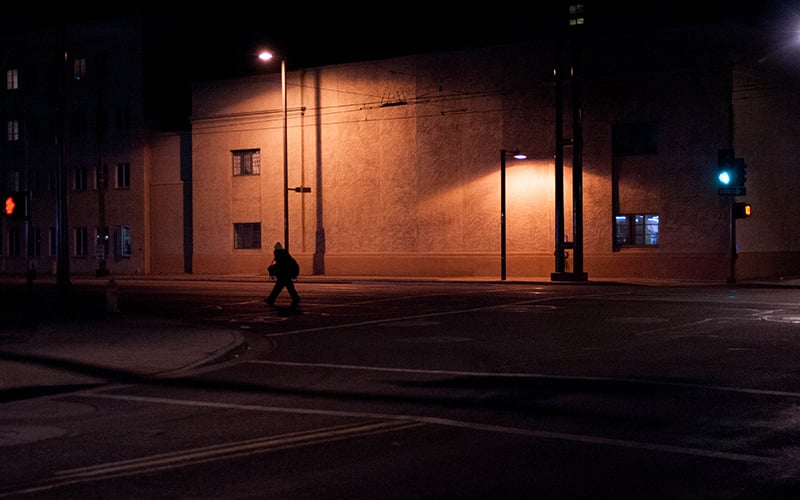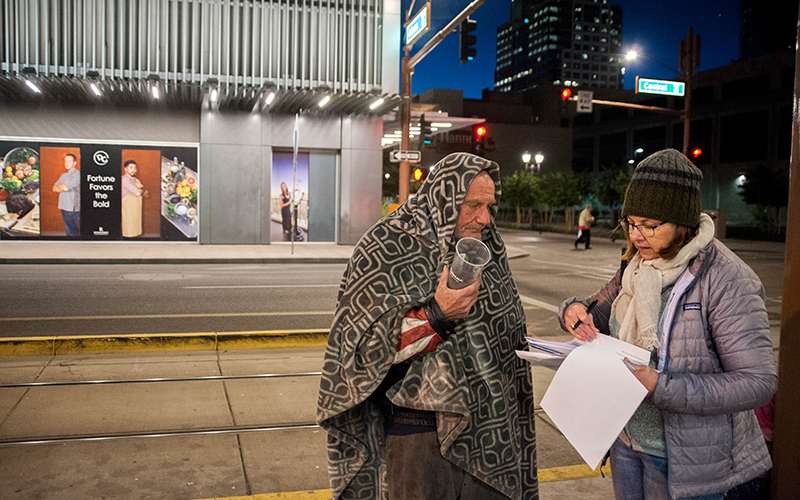
Counting on conversations with people who are homeless to reveal respect, gain resources
By Fortesa Latifi/ Cronkite News |
Charmaine Tyler curls a blanket around her shoulders as she sits on a curb in downtown Phoenix, bracing herself against a 37-degree predawn in three tattered sweaters, sweatpants, socks and sandals.
Anne Scott approaches with a smile and a clipboard.
Good morning, ma’am. I’m talking to people who may be homeless for our survey. Can I ask you a few questions?
Where did you sleep last night?
Is this the first time you’ve been homeless?
If you had to pick one thing, what would be most helpful to you right now?
Scott, who works for a government planning agency, has trained for these few hours on the streets of downtown Phoenix. Dozens like her have spread across sprawling metro Phoenix in what’s officially known as the Point-in-Time Count of the homeless. The federal government requires all states to conduct a count to maintain federal funding for a variety of programs.
The count is meant to help people – sometimes right away, sometimes months later – by identifying the resources they need.
To help, “we need to know who they are, where they are, and understand the factors that led to their homelessness,” according to a website for the Maricopa Association of Governments, or MAG, the regional planning agency that oversees the annual headcount.
The count brings resources to an issue rooted in urban America. Experts say the surveys capture a snapshot rather than complete view of homelessness because of difficulties in counting families and those in jail, as well as a reliance on self-reporting. Still, the in-person survey, which is conducted across the Valley from dawn to noon, may be the single largest county-wide conversation between people who survive on the streets and people who have homes to return to every night.
The overall number of people who are homeless has remained relatively stable over the past three years, according to Point-in-Time, which distinguishes between homeless people in shelters from those living on the streets.
But a closer look at the data is more troubling. The number of people living without shelter in Maricopa County has nearly doubled since 2014, to more than 2,000 last year, according to MAG.
Tyler, who’s 25, said she has been living on the streets in Arizona for 18 months. She isn’t sure whether her family knows she’s homeless, but, even if they did, she doesn’t think they’d help her.
“They have their own lives,” Tyler said. “Now that I’m almost 26, in March, I’m pretty responsible for myself and my own actions in life.”
Scott looked at Tyler as Tyler spoke, only breaking eye contact to record her answers. Then she thanked Tyler for her time and walked on.
Scott, a human-services planner for MAG who has worked on the count for several years, said she was disturbed to see more young people than usual this year.
“The surprising thing is, we’ve talked to a couple of very young folks under 25,” she said. “And I think it’s always heartbreaking to see young people on the streets.”
The agency takes months to enter responses into a database and analyze the data; preliminary data is expected in March. The U.S. Department of Housing and Urban Development requires headcounts to guide policy and funding that is providing more than $38 million to organizations in Arizona.
Sometimes in the middle of a count, census takers immediately send help to those in dire need. Nonprofits are placed on the alert during the count.

Navy veteran Ray Shockley said he sometimes stays at the Westward Ho, but he loves being on the streets. “I feel the need to be out here.” (Photo by Jesse Stawnyczy/Cronkite News)
Ray Shockley was smoking cigarettes he had hand-rolled with scraps of newspapers when Scott approached him. Shockley, with a long beard and fingernails coated in grime, wore a weathered leather jacket and hood pulled over his head. A shopping cart held his earthly possessions.
He said he’d only been on the streets for a few days. Scott doubted that – you don’t build up that level of dirt in a short time – but she didn’t challenge him. Counters are trained to be polite and respect the answers given.
Shockley, at different times, said he had a place at the Westward Ho, a former downtown hotel now used for affordable housing, and that he had been homeless for a long time. He said he receives money from disability payments and has “chosen to do this.”
“I grow and expand by listening to people, and it makes me a better person,” Shockley said as he took a long drag of his cigarette. “I’m learning and growing mentally more than ever before.”
He told Scott he’s a Navy veteran, so she called Health Care for Homeless Veterans, a division of the Department of Veterans Affairs.
“Do you have time to wait for them to come?” Scott asked. “They can give you housing.”
Shockley laughed.
“I don’t have anywhere to be,” he said.
In less than 10 minutes, a blue van pulls up. Shockley sorts through his possessions, including a liquor bottle, takeout boxes and a pair of gloves. The VA employees wait patiently.
“Do you want these papers?” one asked, helping Shockley decide what to throw away and what to take.
A few minutes later, Shockley carries a small bag into the van. The VA employees shut the door behind him and drive away.
“Awesome!” Scott said, beaming. “Awesome! OK, movin’ on.”
It was, she said, the best part of her day.
Rising housing costs in an improving economy and the shutdown of a shelter for men has contributed to an increase in the number of people living on the streets in the county, according to Michael Shafer, an Arizona State University professor.
An overflow shelter that housed 200 men per night was shuttered three years ago because the building wasn’t up to code.
“The closure of the overflow shelter has contributed to that rise,” said Shafer, with the College of Public Service and Community Solutions.
And in the shelters that still are open, there aren’t enough beds. At Central Arizona Shelter Services, all 470 beds are filled most nights of the year, according to Mary Glennon, a program manager at CASS.
“We prioritize youth and we prioritize new clients,” Glennon said. “Then, it’s whatever is kind of left over.”
Some organizations, such as the Society of St. Vincent de Paul, offer shelter as well.
But shelters remain at a premium. Shafer noted that rents rose in downtown Phoenix and other areas as the economy gained momentum.
“What you see is a significant amount of gentrification occurring,” he said. “There’s been very much a tightening of affordable housing stock.”
Nationwide, HUD said, homelessness overall decreased by almost 4 percent over the past three years. However, unsheltered homeless populations have increased nearly 10 percent in the same period.
Arizona’s smaller, more affluent communities are less likely to count people as homeless.
In Cave Creek, on the northern reaches of the Valley, the January homeless count is a one-man job in this town of more than 5,000.
Town Marshal Adam Stein counted just one homeless person during this year’s Point-in-Time Count.
Stein said “once in a blue moon” there are transients who come to Cave Creek, but they rarely stay for long.
“Cave Creek has a food bank, which I think attracts people who are looking for resources,” Stein said. “We have little groups here, pockets of homeless guys that live outside of Cave Creek and wander into town and go to the food bank.”
Stein said the Cave Creek homeless count fluctuates between none and two people each year, but he thinks it’s a valuable resource.
“I hope and pray every year that the numbers go down instead of up — not just in Cave Creek but the entire Valley,” Stein said. “It’s important that we remember these people aren’t invisible. They’re just human beings like you and me.”
Such experts as ASU’s Shafer and leaders at MAG say the count reminds others of the humanity of people who are homeless and need help.
“Any time you bring light and data and truth to a situation, it’s going to increase awareness,” Shafer said.
But the count has limitations.
For one, the survey relies on self-reporting. Counters who ask personal questions about such issues as mental health and HIV will not challenge the answers, even if they don’t seem accurate, Scott said.
And they can’t count everyone who might be homeless.
It’s difficult to track the homeless who are in jail, who are mentally ill or who are with their families.
“Families usually stay in their cars, so they’re not necessarily visible to us,” Scott said. “The last few years, we’ve used family outreach teams so they know where families tend to park.”
About one in four people who are homeless suffer from a severe mental illness, according to the federal Substance Abuse and Mental Health Services Administration.
About half the people who are homeless and booked into Maricopa County jails are severely mentally ill, according to Dawn Noggle, mental-health director for Maricopa County Correctional Health Services.
Maricopa County jail officials recently added four questions to intake surveys to determine whether an inmate is homeless, Noggle said, and they pass that information to MAG for the Point-in-Time Count.
Noggle said jail officials don’t conduct an extensive survey because they have other priorities.
“We’re trying to keep people from dying,” she said. “People are coming in with life-threatening alcohol withdrawal, opioid withdrawal. There really isn’t an ability to do that (question inmates extensively), but at least with these four questions, we can see individuals that are currently homeless or have been in the past year.”
MAG officials expect some changes in the demographics of the 2018 count when it’s publicly released in May, such as an increase in the number of homeless age 62 or older. The prediction is based on anecdotal information from people working at homeless shelters.
“What they’re seeing is a lot of older adults who are entering shelters and staying for a very long time,” Scott said.
This year’s updated survey also will reveal different gender identities. The options now are female, male, trans-female (male to female), trans-male (female to male) and gender non-conforming.
Next year, the Point-in-Time Count might be conducted through a mobile app instead of on paper. The app would record survey responses and help with data aggregation, Scott said. They tested the app with 100 volunteers this year and received positive reviews.
What remains is the stubborn persistence of the homeless issue.
A case in point is John McMillan, who carries an old Starbucks cup with a few coins rattling inside. He said he has been homeless since he was 18. He’s 50 now.
Elizabeth Dacosta, a director for Community Bridges, who helped conduct the Point-in-Time, knows what it’s like. Dacosta, who’s a former heroin addict, said she was homeless for four years, with the last two spent in a shelter. Now, she owns a house.
“I felt compelled to be of service to the people who were still out there,” she said. “They don’t even know how to navigate and access services in our system.”
Scott, several days after the count, said she’s optimistic the survey will do some good.
“We always have hope,” she said. “We wouldn’t do this work if we didn’t have hope for ending homelessness.”
During the count, she had asked Charmaine Tyler what she needed the most. Tyler had a one-word response.
“Freedom.”




Leave a Comment
[fbcomments]